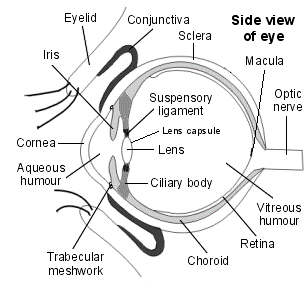By Guild trainer/assesor Linden Pirrone
Eyes are the window to our soul but our eyes are also the window to the outside world. Without clear vision everyday tasks can become an impossible struggle. We often don’t think of the physical and emotional repercussions if our eye sight deteriorates and it is very possible that our lifestyle and overall health could also start to deteriorate as a result of poor eye sight.
Our eyes serve an important function, and it’s important to understand how we can maintain the health of our eyes for the future. Firstly let’s look at the anatomy of the eye.
Basic anatomy
The eyeball of a human weighs approximately 28 grams. There are many parts and functions of the eye however I am only going to focus on the areas that we can often relate to in pharmacy.
Here are four common areas of the eye that you may hear your pharmacist and customers talk about when they are seeking help regarding eye care:
Conjunctiva is the mucous membrane that covers the front of the eye and lines the inside of the eyelids. Contains blood vessels that we often see in or customer’s eyes. When we speak about conjunctivitis, this is the area that is affected the most. So the word conjunctivitis comes from Conjunctiva (the part of the eye) and ‘itis’ meaning inflammation or infection. The cause of this conjunctivitis can be either a virus, bacteria or allergy.
Sclera refers to the outer coat of the eyeball that forms the visible white of the eye and surrounds the optic nerve at the back of the eyeball. Sounds delicate and if we look at the diagram below, it is an area where you cannot see if there is any damage with the naked eye. Anyone who enters your pharmacy that is complaining of severe pain to the eye, perhaps an unknown cause of pain or discomfort should be referred to the pharmacist.
Cornea acts as the eyes outermost lens. It functions like a window that controls and focuses the entry of light into the eye. We often hear that someone has scratched their eye and are often in a great deal of discomfort resulting in constant blinking which can make it hard to see any damage or if there is something in the eye. The end of a mascara wand is a common cause of a scratch to the eye. Ouch! It makes sense why such an injury is so painful. The cornea contains nerve endings that make it extremely sensitive. The cornea can actually heal relatively quickly however customers who believe they have scratched their eye should be referred to the pharmacist and then the optometrist.
Iris is the coloured part of your eye. Your iris controls the size of the pupil and how much light is let into your eye. People with brown eyes are not as sensitive to light as those with lighter coloured irises. This information can come in handy when assessing the needs of our customers.
Functions of the eye.
The average person blinks 12 times per minute – about 10,000 blinks in an average day. Apparently women blink nearly twice as much as men. So why do we blink? The answer seems relatively easy because many of us have tried not blinking when we play a ‘staring content’ game. We blink to add comfort and moisture to our eye. However there is more to the blink of an eye!
So what happens when we blink? A thin film of tears is swept over the eye surface every time you blink. A watery layer of tears is topped with an even thinner coat of lipids (fatty compounds) that help to preserve the film. To maintain eye comfort and health, the tear film needs to remain intact between blinks. Tears are made up of – water, mucin, lipids, lysozyme, lactoferrin, lipocalin, lacritin, immunoglobulins, glucose, urea, sodium, and potassium to name a few. There are 3 different types of tears:
Basil tears – four layers used to lubricate eye and keep dust and debris out
Reflex tears – Wash away harmful substances, much larger amounts, stop microorganisms and antibodies. Tears lubricate the eye and stop the surface from drying out. Some common causes of reflex tears that we often see in pharmacy include allergens, dust and sand.
Emotional tears – causes of emotional tears can be a result of additional stress hormones altering the substances in the basil tears which can then because the blood vessels in the eyes (or the conjunctiva) to become inflamed thus looking red.
What can we recommend to help with eye health?
One of the main forces of defence is to protect our eyes from the sun, wind and other environmental or mechanical factors. There are a number of vitamins and minerals that can assist in eye health. Here are some examples:
- Macu-vision – is a source of antioxidant nutrients which may help preserve macular eye health. It may help defend against free radical damage in the macular region of the retina and the lens of the eye
- Bilberry – used to relieve eyestrain, eye fatigue and eye weariness.
- Lutein – antioxidant. May help protect the macular region of the eye from free radical damage. Increases the density of the protective macular pigment of the retina. Contains omega-3 fatty acids important for eye health.
- Vitamin A – Carrotscontain lots of beta carotene and Vitamin A, which can contribute to your eyes’ health and may provide a fantastic source of eye vitamins for macular degeneration and cataracts.
http://www.betterhealth.vic.gov.au/bhcv2/bhcarticles.nsf/pages/Dry_eye

